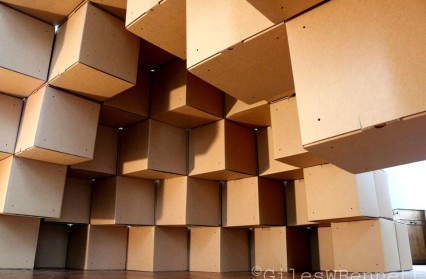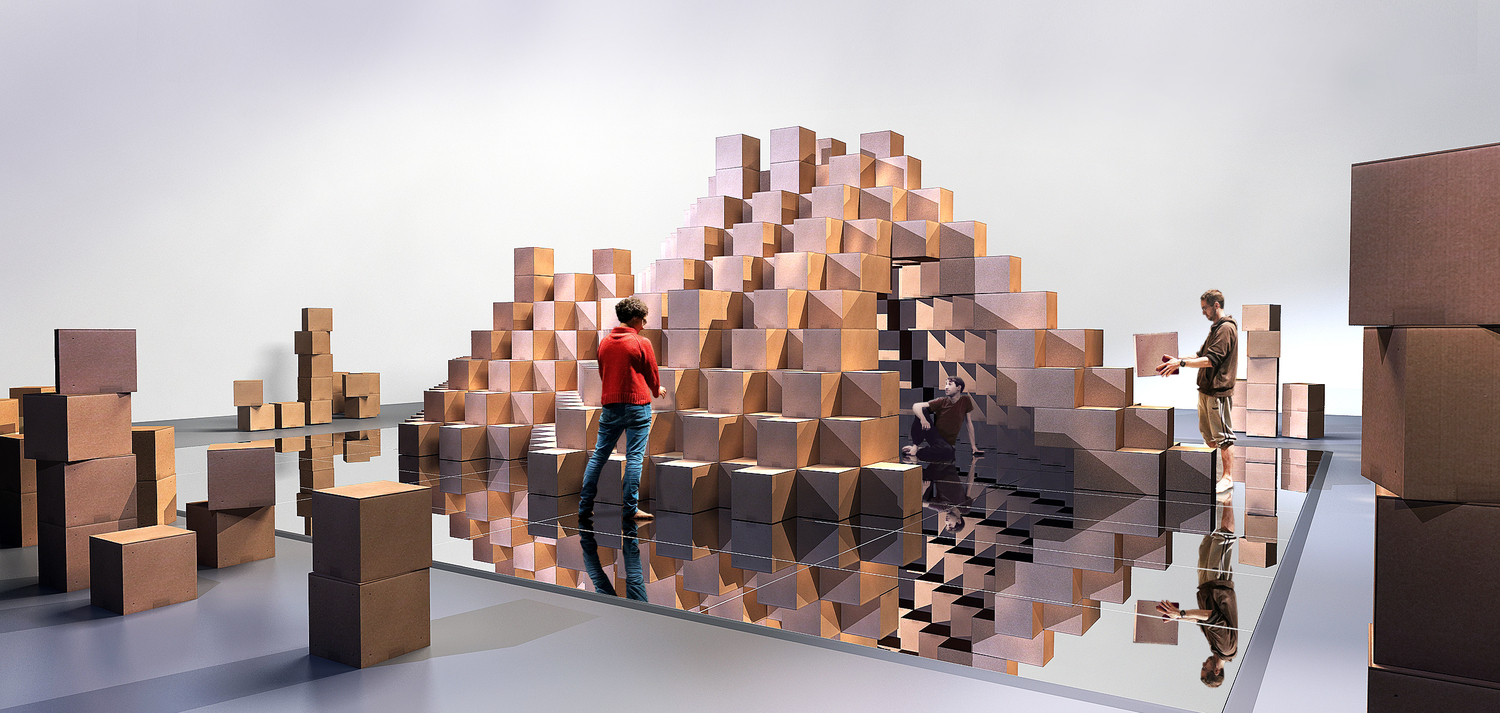Artist Jenny Hall walks us through the germination and creation of her new exhibition, Hollow, which opens at the Aberystwyth Arts Centre on March 23rd.
I’m fascinated by art and architecture that we can play in. Jacob Dahlgren’s ‘The wonderful world of abstraction’ is an installation of ribbons that you alter when you step inside and Diébédo Francis Kéré’s ‘Sensing spaces installation’ at the Royal Academy was a most popular exhibition because it invited people to change the artwork. When a building or sculpture needs to be fixed, rigid and secure it can still be playful – ‘The Longest Bench’ by Studio Weave harnesses the seaside sentiments of candy floss, deck chairs and holidays in the way it ebbs and flows around the town.
I make architecture and artworks for people to bring to life with their own narratives and I wanted to explore some new ideas for making a gathering space, one that might allow for intervention and play. To do this, I headed to Finland as artist in residence at the prestigious Fiskars Village art and design centre with support from Wales Arts International. It was winter and the sun rose so slowly that I could watch it rise twice a day, from the woods above the valley and again from my studio window.
I love Finland. Wildlife is everywhere and the Finns have summer cottages where they spend a month each year fishing, swimming and foraging for wild foods. There is a deep yet simple connection to nature where the sauna provides both a personal sanctuary and the collective rhythm.
It is also home to a design ethos that strips away the inessential, leaving the bare qualities of the material, form and function to resonate. I don’t think these phenomena are separate.
In 2012 when Helsinki was the World Design Capital a temporary pavilion was built in the city centre by the Wood Program students of the Alvar Aalto University. Geometric, fresh and beautiful it offered itself as a family friendly café, workshop space, cinema, restaurant and bar. This was a new type of gathering place. Flexible indoor-outdoor spaces had been created like this before, but rarely with the confident embrace of form and functionality, style and warmth this pavilion created.
Fiskars Village was also celebrated as part of World Design Capital in 2012: the village has the same name as the orange handled scissors that were born there. Fiskars is a multinational corporation but it still has a presence in the beautiful village where it started which is now a thriving arts and cultural space. It also offers an artist in residence program and felt like the place to develop new ideas.
In 2013 I returned to undertake a winter residency at both Fiskars and the Wood Program in Helsinki where I was invited as guest tutor. My aim was to explore design problems from the bottom up – instead of thinking about ‘what to make,’ to think about ‘how to make.’ I also wanted to draw inspiration from nature, to generate ‘an architecture that carries the particular properties, practices and techniques of its location through to the smallest detail,’(1) with the aim of place-making, whether as permanent architecture or ephemeral installation.
I was hugely inspired by the flow of ideas generated at the Wood Program. Each week I would return to the studio with new forms to explore, new puzzles to solve. The process felt rich and rewarding to be making in card, wood and paper, tessellating, reciprocating and creating self-supporting structures and irregular, abstract forms.
At the same time as exploring the world of construction, I was also investigating Fiskars itself. It has a primeval sauna on the edge of a lake, a dance pavilion, jetties onto the water, sculptures dotted throughout the landscape and an industrial architecture that has been converted into fine restaurants and artisanal shops. It is a place where the commodification of the earth and the resultant wealth creation is simultaneously visible. Fiskars honours its industrial heritage and has a fantastic archive for exploration. There I found a drawing of one of the mines that supplied copper ore to Fiskars in the late 19th century. This beautiful image, a cross-section of Orijärvi mine haunted me. It was an artist’s impression of the vast mine underground. How had it been created? Did the artist make a measured study? Was it described by the miners or was it a visual impression? The National Geological Society say that no other records exist – when Orijärvi was exhausted it filled with water and remains unexplored.
This beautiful underground hollow became my muse. I explored its form in drawings and models asking how I could make visible the idea that a mine is a mirror of the culture above ground that had blossomed in its wake. I felt that by creating a modular structure I would be able to convey the industrial drivers behind mining – the commodification of the earth and the displacement of material so that the destruction of one thing enables the construction of another. I had the kernel of an idea for a building block structure that would contain a hollow space.
When I returned home to Wales, I started to consider how people might engage with this piece of work and at what scale. Dr Andrew Filmer of the Theatre, Film & TV department at Aberystwyth University and I created a workshop called Play, Space and Performance where we explored the theatrics of construction using cardboard cubes with a group of actors, choreographers and devisers. The workshop was fascinating and it seemed that I would be able to create an installation that responded to different qualities I value in architecture: playful, adaptable, metaphorical and beautiful.
Hollow launches on 23 March at the Aberystwyth Arts Centre thanks to The Arts Council of Wales. It will then tour to Ceredigion Museum with a linked exhibition exploring ‘Mining for stories’ and then onto Undegun in Wrexham and the re-imagined Muni in Pontypridd.
Hollow is not the only piece of work to come out of my residency in Finland. The experience hugely informed my ideas about creating site specific architecture as well as stimulating new lines of enquiry for making work. It is very satisfying however to see Hollow coming to fruition. I do hope it offers itself for contemplation, connection and play and continues to inform my development of participatory architecture.
Footnote:
1 ‘Crafted – The Ingredients of Architecture’ by Pekka Heikinen, Director of the Wood Program
Jenny has been artist in residence at Aberystwyth Arts Centre for 12 months and is the director of architectural design practice Craftedspace.
Find out more about the symposium and workshops connected to the exhibition at www.hollow.info.













